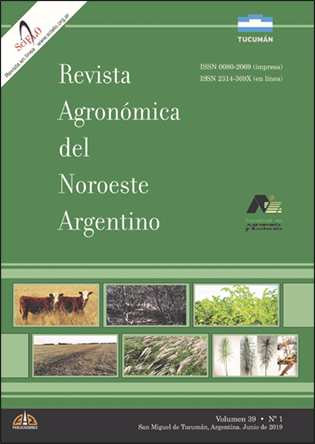View Item
- xmlui.general.dspace_homeCentros e Institutos de InvestigaciónCIAP. Centro de Investigaciones AgropecuariasInstituto de Investigación Animal del Chaco SemiáridoArtículos científicosxmlui.ArtifactBrowser.ItemViewer.trail
- DSpace Home
- Centros e Institutos de Investigación
- CIAP. Centro de Investigaciones Agropecuarias
- Instituto de Investigación Animal del Chaco Semiárido
- Artículos científicos
- View Item
Efecto de la edad al primer parto y el manejo nutricional sobre la longevidad y productividad en vacas de cría
Abstract
La edad al primer parto indica el inicio de la vida productiva de los animales, y se relaciona con la longevidad de los vientres. El presente trabajo tuvo como objetivos: a) evaluar la eficiencia productiva hasta el primer destete, de vaquillonas recriadas para obtener su primer parto a los 24 o 36 meses de vida; b) evaluar el efecto de la edad al primer parto y el manejo nutricional diferencial sobre la supervivencia de vacas. El trabajo se realizó en el
[ver mas...]
La edad al primer parto indica el inicio de la vida productiva de los animales, y se relaciona con la longevidad de los vientres. El presente trabajo tuvo como objetivos: a) evaluar la eficiencia productiva hasta el primer destete, de vaquillonas recriadas para obtener su primer parto a los 24 o 36 meses de vida; b) evaluar el efecto de la edad al primer parto y el manejo nutricional diferencial sobre la supervivencia de vacas. El trabajo se realizó en el Instituto de Investigación Animal del Chaco Semiárido, Leales, Tucumán. Los tratamientos se definieron mediante la combinación de la edad al primer parto (24 o 36 meses) y manejo nutricional a partir de la segunda preñez (con y sin suplementación con silaje de planta entera de maíz): G1) primer parto a los 36 meses y suplementación; G2) primer parto a los 36 meses sin suplementación; G3) primer parto a los 24 meses y suplementación; G4) primer parto a los 24 meses sin suplementación. El análisis de supervivencia se realizó mediante el estimador de Kaplan y Meier y la regresión de Cox. Los resultados muestran que la probabilidad de supervivencia global hasta el cuarto destete fue de 0.41, 0.35, 0.38 y 0.18 para G1, G2, G3 y G4, respectivamente (log-rank; P < 0.01). El grupo 4 fue el que mostró la menor producción acumulada hasta el cuarto destete. Se concluye que adelantar la edad de parto no resulta eficiente en sistemas pastoriles puros basados en pastizales naturales o gramíneas megatérmicas implantadas.
[Cerrar]
The age at first calving indicates the beginning of the productive life of dams, and it is related with their longevity. The objectives of this study were: a) to evaluate the productive efficiency at first weaning of heifers reared to obtain their first calving at 24 or 36 month of age; b) to evaluate the age at first calving and differential nutritional strategies on cows survival. The work was carried out at the Instituto de Investigación Animal del
[ver mas...]
The age at first calving indicates the beginning of the productive life of dams, and it is related with their longevity. The objectives of this study were: a) to evaluate the productive efficiency at first weaning of heifers reared to obtain their first calving at 24 or 36 month of age; b) to evaluate the age at first calving and differential nutritional strategies on cows survival. The work was carried out at the Instituto de Investigación Animal del Chaco Semiárido, Leales, Tucumán. The treatments were defined by combining the age of first calving (24 and 36 months) and nutritional management: G1) first calving at 36 months and supplementation; G2) first calving at 36 months without supplementation; G3) first calving at 24 months and supplementation; G4) first calving at 24 months without supplementation. The survival analysis was performed using the Kaplan and Meier estimator and the Cox regression. The results show that the probability of overall survival until the fourth weaning was 0.41, 0.35, 0.38 and 0.18 for G1, G2, G3 and G4, respectively (log-rank, P <0.01). Group 4 was the one that showed the lowest cumulative production until the fourth weaning. It is concluded that advancing/anticipating the calving age is not efficient in pure pastoral systems based on natural pastures or implanted megathermal grasses.
[Cerrar]

Fuente
Revista Agronómica del Noroeste Argentino 39 (1) : 53-61 (junio 2019)
Date
2019-06-26
Editorial
Facultad de Agronomía y Zootecnia, Universidad Nacional de Tucumán
ISSN
0080-2069
2314-369X (online)
2314-369X (online)
Formato
pdf
Tipo de documento
artículo
Palabras Claves
Derechos de acceso
Abierto
 Excepto donde se diga explicitamente, este item se publica bajo la siguiente descripción: Creative Commons Attribution-NonCommercial-ShareAlike 2.5 Unported (CC BY-NC-SA 2.5)
Excepto donde se diga explicitamente, este item se publica bajo la siguiente descripción: Creative Commons Attribution-NonCommercial-ShareAlike 2.5 Unported (CC BY-NC-SA 2.5)


